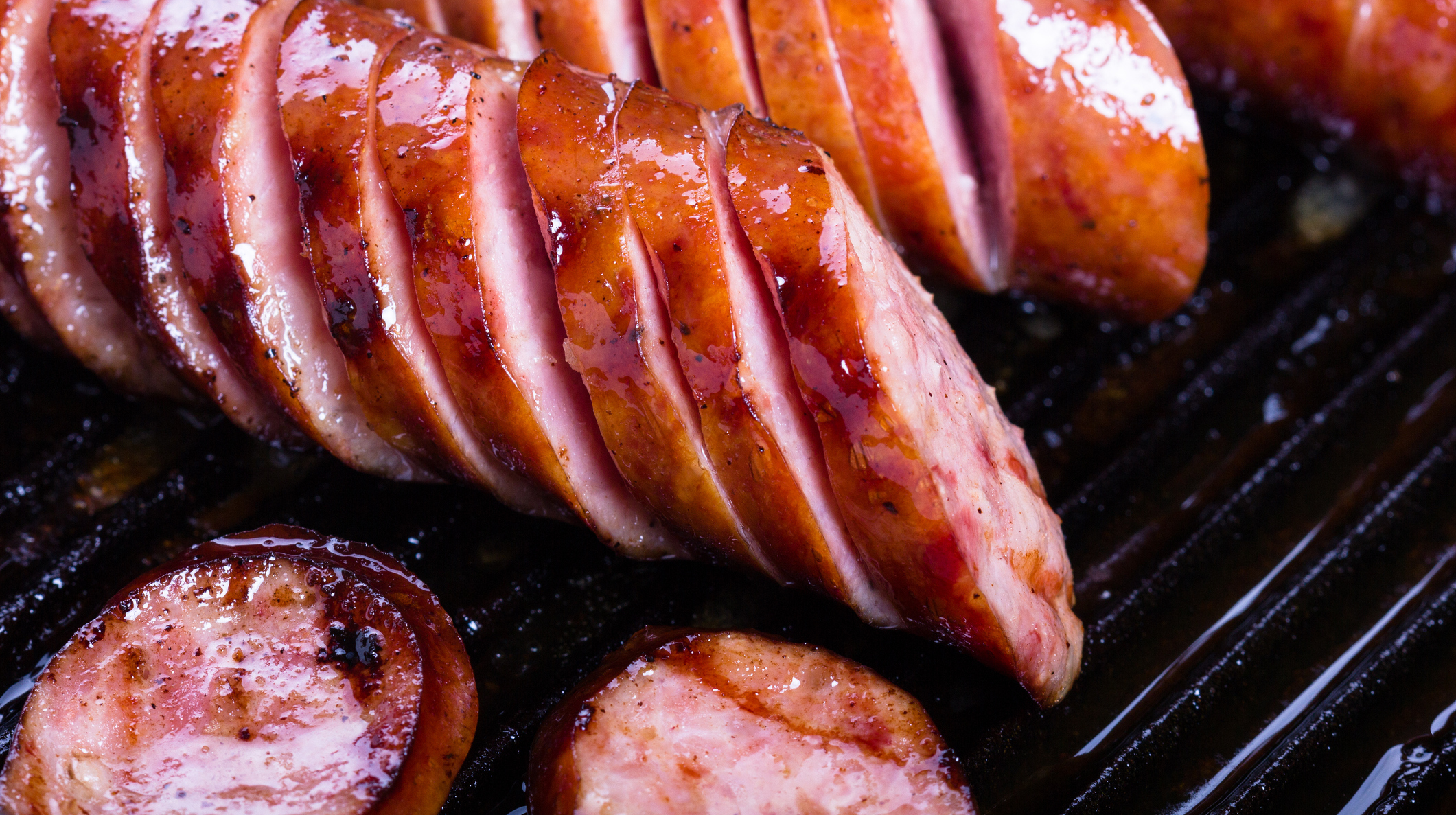Kielbasa Is The Polish Sausage That Found An American Home
Somewhere in her house, my mom possesses a box of handwritten recipes, either transcribed or handed down from my Polish grandmother. Pickle soup. Cabbage rolls. Krusciki. They're largely useless, full of super-helpful descriptions like "a little bit of salt" or "as much as you need" of flour, or "vinegar as to your taste."
Perhaps because of that, or of a laziness unrelated, my mom uses none of those recipes. It's not that she doesn't need them. She's more a modern-day cook of convenience. Her refrigerator contains enough jars of pickles to feed an army for a week, but they are all store-bought. She even buys jarred sauerkraut. And the kielbasa she keeps—that sausage so much a staple of Polish cuisine that in Poland the government regulates its ingredients and appearance—is and always has been from Hillshire Farms.
I grew up with Hillshire Farms as the "Polish sausage" I associated with my family and my national origin. And if you know kielbasa, it's likely you grew up with it, too. Consumer surveys have shown Hillshire Farms to be the No. 2 most popular mass-market sausage brand in the United States, behind Jimmy Dean, and the smoked "Polska Kielbasa" is Hillshire's signature link.
Don't mistake me when I say it's mass-market—I don't say this as a pejorative. It's what I have loved since I was a young'un. When sliced diagonal, about 1/3-inch thick, sautéed in a pan with additional fat until those sausage ovals are both plumped and crisped and slightly curled, then doused in ketchup (then, later in my life, stone-ground mustard and/or pickled cabbage), those store-bought, U-shaped sausages are part of my DNA—literally—and how I view myself as a mostly-Polish-American.
Kielbasa is a simple sausage: minced pork, generous amount of garlic, a little bit of marjoram and black pepper. It's also undeniably the Polish export that's broken through most into the American conscience—as pizza has for Italians and sushi has for the Japanese. That's perhaps the best indication a foodstuff has become mainstream American: We no longer view pizza, sushi, or kielbasas as "ethnic."

The founder of Hillshire Farms, an Austrian named Fritz Bernegger who immigrated to the U.S. at 22 and, a couple years later in 1928, took a job in New London, Wisconsin taking a job "to make good sausage," helped popularize kielbasa in America. (This biographical info of Bernegger comes, of course, directly from the Wisconsin Meat Industry Hall Of Fame housed at the University of Wisconsin—Madison, which calls Mr. Bernegger a "pioneer" in the meat industry who was "especially proud" of his smoked sausages.) By the 1960s, his company had expanded greatly. It was absorbed by Consolidated Foods, which was later renamed Sara Lee.
The kielbasa Americans are most likely familiar with—the "Polish sausage" or "Polish dog" that's available at almost every ballpark, big-city food cart, country fair and grocery store across our union—is smoked. Technically, it's a Polska kielbasa wedzona—a smoked sausage. That's because "kielbasa" in Polish just means "sausage." If you find yourself in a Polish deli or restaurant, you'll likely find several types of kielbasa: farmer's, fresh, Krakow-style. The smoked one that Americans know best can be eaten without further preparation.
Polska kielbasa's flavor is not too complicated, not off-putting. The garlic gives it some zest, but not a harsh bite. Maybe that's why it's so popular: It's a few rungs up the fancy ladder from a hot dog—more plump and substantial—but it's not too artisanal or exotic. A wildly unscientific online survey conducted a few years back by the National Hot Dog And Sausage Council showed kielbasa to be twice as popular in the U.S. as chorizo and almost five times as popular as andouille. But no cross-tabs were made available, so I can't speak to the methodology of the survey or of how many of the 1,700 American sausage-eaters surveyed live in Chicago or Brooklyn or Milwaukee.
It is a wonder that kielbasa—or "kielbasi," sounding like keel-BAHS-ee, as my Polish grandpa would call it—has become so common in the U.S. while other similar sausages, such as the Portuguese linguica or the Creole andouille, remain regional or niche. Most Americans likely can't name three Polish food items. Bigos? Nope. Beet soup? Probably not. Pierogi? Yes, perhaps—"but aren't those Russian?"
Why has kielbasa become—like tacos and ménage-à-trois—a foreign idea that Americans have embraced?

According to Sara Lisicki, who runs the Polska Kuchnia restaurant in Stanwood, Washington, with her husband Wojtek, it's because kielbasa, along with most other Polish foods, are simple, but time-consuming to make. Few families—even Polish ones—have the time (or desire) to make the filling, then stuff and fold pierogis, roll golabek, and ferment cucumbers or cabbage for surowka salad.
I think the explanation has to be a little more base than that. Because, honestly, in what household in America these days is any type of sausage made? Do Americans make their own hot dogs? No. I think it might just be fun to order "the Polish." It's a sausage, and that's inherently funny. It's called a "Polish," and that makes sense.
I visited the Polska Kuchnia on a recent weekend. They run a small restaurant on the street side of the kitchen now, with the friendliest service you'll ever receive. I came home with four links of their smoked Polska kielbasa, and made it my favorite low-brow way: sliced in half lengthwise, slathered with ketchup, and placed between two slices of white bread. The way my mom likes. (And yes, that does indeed turn a Polish "dog" into a "sandwich." Case closed.)
